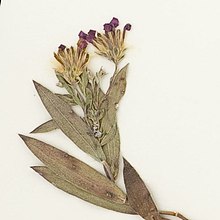bio.wikisort.org - Plant
Symphyotrichum lucayanum (formerly Aster lucayanus) is a species of flowering plant of the aster family (Asteraceae) endemic to the North American island of Grand Bahama.[3]
| Symphyotrichum lucayanum | |
|---|---|
 | |
Conservation status | |
| Scientific classification | |
| Kingdom: | Plantae |
| Clade: | Tracheophytes |
| Clade: | Angiosperms |
| Clade: | Eudicots |
| Clade: | Asterids |
| Order: | Asterales |
| Family: | Asteraceae |
| Tribe: | Astereae |
| Subtribe: | Symphyotrichinae |
| Genus: | Symphyotrichum |
| Subgenus: | Symphyotrichum subg. Virgulus |
| Species: | S. lucayanum |
| Binomial name | |
| Symphyotrichum lucayanum | |
 | |
| Endemic to Grand Bahama island[3] | |
| Synonyms[2] | |
| |
Commonly known as pineland aster, it is a perennial, herbaceous plant that may reach 50 centimeters (20 inches) high. Each flower head has many tiny florets put together into what appear as one. Symphyotrichum lucayanum has purple ray florets.[3]
The holotype for the basionym Aster lucayanus was collected 5 February 1905 at Eight Mile Rock[4] which is roughly at coordinates 26.5462°N 78.8087°W.[lower-alpha 1] The holotype is stored in the New York Botanical Garden Steere Herbarium, and a high-definition image of it can be found online.[5]
![Holotype of Aster lucayanus stored in the NYBG.[5]](http://upload.wikimedia.org/wikipedia/commons/thumb/c/c9/NYBG-Aster-lucayanus-holotype-00115522.jpg/220px-NYBG-Aster-lucayanus-holotype-00115522.jpg)
Notes
- These coordinates are near the present-day Eight Mile Rock police station and high school and were obtained through Google Maps.
Citations
References
- Britton, N.L. (1906). "Contributions to the flora of the Bahama Islands III". Bulletin of the New York Botanical Garden. Lancaster, Pennsylvania: Published for the Garden by the New Era Printing Co. 4: 137–143. Retrieved 31 January 2021 – via Biodiversity Heritage Library.
- Freid, E.H. (2019). "Symphyotrichum lucayanum". IUCN Red List of Threatened Species. 2019. doi:10.2305/IUCN.UK.2019-2.RLTS.T137682802A137682944.en. ISSN 2307-8235. Retrieved 31 January 2021.
- Leon Levy Native Plant Preserve (n.d.). "Symphyotrichum lucayanum". www.levypreserve.org. Nassau: Bahamas National Trust. Retrieved 31 January 2021.
- POWO (2019). "Symphyotrichum lucayanum (Britton) G.L.Nesom". Plants of the World Online. Royal Botanic Gardens, Kew. Retrieved 31 January 2021.
- Ramirez, J.; Tulig, M.; Watson, K.; Thiers, B. (2021). "Occurrence 5 February 1905 - Aster lucayanus Britt. - Collected in Bahamas - Holotype". The New York Botanical Garden Herbarium (NY). Version 1.30. The New York Botanical Garden. Occurrence dataset (doi.org/10.15468/6e8nje). Retrieved 31 January 2021 – via GBIF.
Текст в блоке "Читать" взят с сайта "Википедия" и доступен по лицензии Creative Commons Attribution-ShareAlike; в отдельных случаях могут действовать дополнительные условия.
Другой контент может иметь иную лицензию. Перед использованием материалов сайта WikiSort.org внимательно изучите правила лицензирования конкретных элементов наполнения сайта.
Другой контент может иметь иную лицензию. Перед использованием материалов сайта WikiSort.org внимательно изучите правила лицензирования конкретных элементов наполнения сайта.
2019-2025
WikiSort.org - проект по пересортировке и дополнению контента Википедии
WikiSort.org - проект по пересортировке и дополнению контента Википедии
